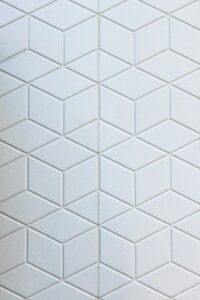When it comes to flooring options, the choices can be overwhelming. Among the myriad options available, ceramic and porcelain tiles often stand out, showcasing a striking resemblance that can easily confuse buyers. While these two may seem like two peas in a pod, a closer inspection reveals nuanced differences that can significantly impact your choice. Complicating matters further, the terms ‘ceramic tiles’ and ‘porcelain tiles’ are often used interchangeably, contributing to the confusion. To aid in making an informed decision, let’s delve into the details of the ceramic vs. porcelain tiles comparison.
Ceramic tiles have long been a staple in home design, offering a versatile and cost-effective solution for various applications. Made from red, brown, and white clay, these tiles are kiln-fired at lower temperatures, resulting in a more porous, less dense, and softer product compared to porcelain tiles. In this article, we will delve into the characteristics, uses, and advantages of ceramic tiles, shedding light on why they remain a popular choice for flooring, particularly in warm climates.
Characteristics of Ceramic Tiles:
The key components of ceramic tiles—red, brown, and white clay—contribute to their distinct characteristics. The lower firing temperatures during production make ceramic tiles more porous, giving them a unique texture and appearance. While this porosity can make them more susceptible to stains and damage, it also enhances their cooling effect, making them an ideal choice for homes in warmer regions.
The clay used in ceramic tiles is less refined compared to porcelain, making these tiles more affordable. This affordability opens up opportunities for homeowners to embrace the aesthetic appeal of ceramic tiles without breaking the bank. However, it’s essential to acknowledge that this cost-effectiveness comes with a trade-off in terms of durability when compared to their porcelain counterparts.
Uses of Ceramic Tiles:
One of the primary applications of ceramic tiles is in flooring, especially in homes located in warm climates. The cooling effect of ceramic tiles provides a welcome relief from the scorching sun, making them a practical and aesthetically pleasing choice. The variety of colors, patterns, and sizes available in ceramic tiles allows for creative and customizable flooring designs, adding a touch of personalization to any space.
Ceramic tiles are not limited to flooring; their versatility extends to walls, countertops, and even decorative elements. In kitchens and bathrooms, where moisture resistance is crucial, ceramic tiles are often employed for their durability and easy maintenance. The ability to withstand spills and frequent cleaning makes them a practical choice for spaces prone to moisture and high traffic.
Advantages and Considerations:
The affordability of ceramic tiles is undoubtedly one of their major advantages, making them accessible to a wide range of homeowners. The diverse range of styles and designs further contributes to their popularity, allowing individuals to express their unique tastes and preferences through their choice of tiles.
However, it’s important to consider the trade-offs associated with ceramic tiles. Their lower density and increased porosity make them more prone to chips, cracks, and stains compared to porcelain tiles. In high-traffic areas or spaces where heavy furniture is present, homeowners may need to exercise caution to prevent potential damage.
Choosing Between Ceramic and Porcelain Tiles: A Comprehensive Guide for Homeowners
Selecting the right type of tile for your home is a crucial decision, as it not only influences the aesthetic appeal but also determines the durability and functionality of the surface. Ceramic and porcelain tiles are popular choices for various applications, each with its own set of advantages and disadvantages. In this guide, we will delve into the distinctions between ceramic and porcelain tiles to help you make an informed decision based on your specific needs.
Ceramic Tiles:
Ceramic tiles are a cost-effective option that is well-suited for low-traffic areas within the home. Made from a mixture of clay, minerals, and water, ceramic tiles are kiln-fired at lower temperatures than porcelain tiles. This results in a product that is less dense and more porous compared to its porcelain counterpart. While ceramic tiles may not be as durable as porcelain, they are an excellent choice for areas where foot traffic is minimal, such as bedrooms and bathrooms.
One of the key advantages of ceramic tiles is their affordability, making them an attractive option for budget-conscious homeowners. They come in a wide range of colors, patterns, and sizes, allowing for creative and customizable designs to enhance the overall look of your space.
Porcelain Tiles:
Porcelain tiles, on the other hand, are renowned for their durability and versatility. Composed of finer clay and fired at higher temperatures, porcelain tiles are denser, less porous, and more resistant to moisture. This makes them an ideal choice for both interior and exterior applications, including bathrooms, kitchens, and outdoor patios.
The low water absorption rate of porcelain tiles makes them highly resistant to stains, mold, and mildew, making them an excellent choice for areas with high moisture levels. Porcelain tiles are also suitable for high-traffic areas, such as entryways and living rooms, where their robust nature can withstand heavy use over time.
Maintenance and Longevity:
Both ceramic and porcelain tiles are relatively easy to maintain. Regular cleaning and periodic resealing of grout will contribute to their long-term durability. However, it’s crucial to note that the level of maintenance may differ slightly between the two types.
Ceramic tiles may require more frequent cleaning and sealing due to their higher porosity, especially in areas prone to spills and moisture. Porcelain tiles, with their lower water absorption rate, are more forgiving in terms of maintenance, making them an attractive option for busy households.
